Review of the project
This research aims to analyze and summarize the rapidly changing literature on vacuum automation technology. The study offers a viewpoint into relatively recent work, emphasizing empirical research on vacuum automation technologies, particularly developing and adapting the Framework of Technology in the process. The increasing interest in technology focuses on social and public values, so the effectiveness is enhanced to consider this literature. Despite its effectiveness, vacuum automation technology may occasionally encounter difficulties if the surface of the object it is supposed to grab is rough or has many holes. I organize the research into several categories according to how performance is measured, make conclusions on the vacuum automation technology evaluation today, and make suggestions for future research.
1.0 Introduction
Researchers and businesspersons keep discovering vacuum automation technology to be of interest as they study academic articles in quest of information they can put to practical use(Kupperberg,2009). Technological research findings and theoretical advancements change quickly, as with many popular study topics, particularly those studied by academics from various disciplines. In particular, this research focuses on the vacuum automated process components and solutions to enable grasping, lifting, and moving applications for our customers in many industries, emphasizing packaging, food and beverage, pharmaceutical, chemical, logistics and warehousing, plastics, and automotive. The evaluation of vacuum automation technology is now being studied mainly through empirical and qualitative research (Gouverneur et al.,2019). As we can see in this research, the current study also considers the increasing need for vacuum automation technology focused on social and public values. As a result, the effectiveness is increased by considering this literature.
1.1 The State of the Art(SOTA)
Any industrial engineering project must consider stating the art, which is the highest level of advancement in a design, process, material, or technology (Soong, & Spencer Jr, 2002). It is a crucial period in any research and development process that shows the originality of a project’s or research’s findings. In the business world, it refers to the complete body of information and the highest level attained thus far on the topic, approach, technology, or material engineering being studied or innovated.
2.0 Methodology in Piab Company
2.1 Lean manufacturing
Piab employs lean manufacturing techniques to streamline its production workflow and eliminate waste. This strategy contributes to increased productivity, cost savings, and client satisfaction.
2.2 Design thinking
Piab company creates innovative products and solutions that satisfy customer needs by utilizing design thinking. This methodology emphasizes empathy, experimentation, and iteration while taking a customer-centered approach to problem-solving.
2.3 Six Sigma
Piab company also employs the Six Sigma methodology to raise the caliber of its outputs and operational procedures. This strategy uses statistical analysis and data-driven decision-making to reduce errors and variability.
2.4 Agile development
Piab employs agile development approaches to produce responsive, adaptable products responding to shifting market conditions and customer demands. Collaboration, communication, and quick iteration are prioritized in this strategy.
3.0 Literature review
- Piab’s article, “Efficient Vacuum Technology for Industrial Automation,” An overview of Piab’s vacuum technology and its uses in numerous sectors, is given in this technical pamphlet. The brochure promotes Piab’s cutting-edge goods, such as suction cups and energy-efficient vacuum pumps for quick automation systems.
- “Piab’s End-of-Arm Tooling: Optimizing Automation” by Robotics Next day: The end-of-arm tooling (EOAT) solutions from Piab are covered in this article since they are made to handle items accurately and effectively in robotic automation systems. The customizable EOAT products from Piab, which are made to satisfy the particular requirements of various industries, are highlighted in the article.
- Piab’s “Vacuum Technology for the Packing Industry” This white paper focuses on how vacuum technology may boost production and efficiency in the packaging sector. The article presents Piab’s vacuum technology solutions, which may be used to manage different packaging materials. These solutions include vacuum pumps and suction cups.
4.0 Results
A comprehensive set of experiments was conducted to evaluate the design and operation of one of the vacuum automation systems, the vacuum gripper, as shown in Figure 4.0. The whole experiment process was carried out in automated mode. A straightforward blob-detection technique was used to locate the objects on the smooth surface of the conveyer belt. A pressure sensor was automatically installed to detect the pressure of the suction. The deduced results are summarized in Table 1.

Table 1: Material Classification and Resulting Performances
5.0 Discussion
The results in table 1 show that in most of the tested recyclable wastes, the custom-made section cup outperformed its rivals. Furthermore, it achieved highly competitive scores despite failing to perform best. Therefore, its average scores are substantially more significant than any other suction cup.
6.0 Vacuum technology and automation solutions in Piab company
Piab is a company that specializes in offering automation and vacuum technology solutions. Its products, which are employed in automation and material handling applications, include vacuum pumps, suction cups, and various grippers.
6.1 Vacuum pumps
Piab provides a variety of vacuum pumps, as shown in Figure 6.1, and accessories for use in various vacuum-related applications, including vacuum lifting, vacuum conveying, and vacuum packing. Their vacuum pumps are available in various sizes and capacities, and electric and pneumatic variants are available. To create a vacuum in various applications, various vacuum pumps, including multi-stage ejector pumps, pumps using COAX® technology, and vacuum generators.
6.2 Suction cups
The Piab firm sells a variety of suction cups, as shown in the sample in figure 6.2, that can be used to lift and grip various objects, including bags, cartons, and sheets of glass or metal. These suction cups can be modified to fit specific application requirements and are made to offer a powerful hold. The suction cups from Piab company utilize cutting-edge technology to deliver a firm grip on various surfaces, even rough and uneven ones. To accommodate various uses, the firm offers a variety of suction cup designs.
6.3 Vacuum grippers
End-effectors of the vacuum gripper variety are used in robotics and automation to pick up and manipulate objects. They draw a vacuum between the gripper and the object, which generates a suction force that firmly grips the thing. Robotic systems and automation applications pick up and move objects using Piab’s vacuum grippers. The company provides a selection of gripper designs, including modular and personalized choices, as shown in the sample in Figure 6.3.
6.4 COAX® technology
It is based on the multi-stage ejector technology principle, which offers a more effective and energy-saving vacuum production method than conventional vacuum generators. By using COAX® technology, a vacuum is produced by connecting several ejectors in parallel. Each ejector has a nozzle that emits a compressed air jet traveling at high speed, as shown in the sample in Figure 6.4. This compressed air jet entrains and compresses a greater volume of air or gas, generating a vacuum. Compared to conventional vacuum generators, the numerous stages of ejectors offer a higher vacuum flow rate, quicker evacuation times, and less energy use. Vacuum pumps and other products from Piab company employ the proprietary COAX® technology to deliver high vacuum flow rates with little energy usage. This method uses a multi-stage ejector design that generates a compressed air vacuum.
7.0 Aim of the project
This research aims to provide vacuum technology-related businesses with creative and effective automation solutions. Piab Automation Technologies seeks to increase productivity, improve safety, and lower client costs through cutting-edge automation solutions. They offer goods including vacuum pumps, suction cups, and gripping tools in addition to specialized automation systems created to satisfy the individual requirements of their customers. Piab Automation Technology’s overarching objective is to assist companies in streamlining their operations and achieving tremendous success in their particular industries.
8.0 Conclusion
Piab Automation Technology aims to provide vacuum technology-related businesses with creative and effective automation solutions. Piab Automation Technologies seeks to increase productivity, improve safety, and lower client costs through its cutting-edge automation solutions. They offer goods including vacuum pumps, suction cups, and gripping tools in addition to specialized automation systems created to satisfy the individual requirements of their customers. Piab Automation Technology’s overarching objective is to assist companies in streamlining their operations and achieving tremendous success in their particular industries.
9.0 Recommendations
There are some areas that Piab Vacuum Automation Technology, a highly regarded business with a variety of cutting-edge goods and services, may improve.
9.1 Expand their product line
Although Piab provides various vacuum technology products, there is room for them to diversify their offering of automation solutions. They could better serve the unique requirements of a more extensive range of sectors, as a result, growing their market share.
9.2 Enhance their online presence
Even though Piab has a website and social media profiles, it might want to improve its internet visibility. This can entail adding more exciting and educational material to their website and social media pages and utilizing more potent search engine optimization (SEO) techniques to increase their presence in search results.
9.3 Increase customer support
Piab offers customer service, although there may be room for improvement here. They could serve their consumers better if they improved their support services by expanding their training programs and providing more prompt technical support.
9.4 Develop more sustainable products
While Piab has made some attempts to improve energy efficiency, there is always room to create even more environmentally friendly goods. This can entail adopting more environmentally friendly materials and lowering the adverse effects of their operations on the environment.
Strong business Piab Vacuum Automation Technologies offers a wide range of excellent goods and services. Putting these suggestions into practice might aid businesses in growing their customer base and improving customer service while supporting sustainable initiatives.
Piab company is well known for offering cutting-edge, personalized automation solutions. Its emphasis on vacuum technology has allowed them to create energy-efficient and highly accurate devices. These products have proven helpful in a variety of industries, including the processing and packaging of food. Piab has built a solid reputation in the automation sector thanks to its dedication to sustainability and client satisfaction. However, they have room for improvement. Piab Vacuum Automation Technology seems a reliable and beneficial tool for companies trying to improve productivity and success.
10.0 References
Li, S., Stampfli, J. J., Xu, H. J., Malkin, E., Diaz, E. V., Rus, D., & Wood, R. J. (2019, May). A vacuum-driven origami “magic-ball” soft gripper. In 2019 International Conference on Robotics and Automation (ICRA) (pp. 7401-7408). IEEE.
Kupperberg, P. (2009). Jerry Yang. Infobase Publishing.
Zawacki-Richter, O., Marín, V. I., Bond, M., & Gouverneur, F. (2019). A systematic review of research on artificial intelligence applications in higher education–where are the educators? International Journal of Educational Technology in Higher Education, 16(1), 1-27.
Soong, T. T., & Spencer Jr, B. F. (2002). Supplemental energy dissipation: state-of-the-art and state-of-the-practice. Engineering structures, 24(3), 243-259.
Gabriel, F., Fahning, M., Meiners, J., Dietrich, F., & Dröder, K. (2020). Modeling of vacuum grippers for the design of energy-efficient vacuum-based handling processes. Production Engineering, 14, 545-554.
Varnakov, S. N., Lepeshev, A. A., Ovchinnikov, S. G., Parshin, A. S., Korshunov, M. M., & Nevoral, P. (2004). Automation of Technological Equipment for Obtaining Multilayer Structures in an Ultrahigh Vacuum. Instruments & Experimental Techniques, 47(6).
Fernández, C., Manyà, F., Mateu, C., & Sole-Mauri, F. (2014). Modeling energy consumption in automated vacuum waste collection systems. Environmental Modelling & Software, 56, 63-73.
Gabriel, F., Fahning, M., Meiners, J., Dietrich, F., & Dröder, K. (2020). Modeling of vacuum grippers for the design of energy-efficient vacuum-based handling processes. Production Engineering, 14, 545-554.
Wolff, J. O., Gorb, S. N., Wolff, J. O., & Gorb, S. N. (2016). Suction cups. Attachment Structures and Adhesive Secretions in Arachnids, 87-93.
11.0 Appendices

Figure 4.0 The composite system performing recyclable waste sorting
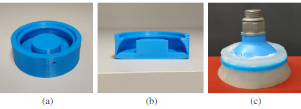
Figure 6.2 Suction cups a) Mold assembly b) Mold section view c) Suction cup with compliant insert
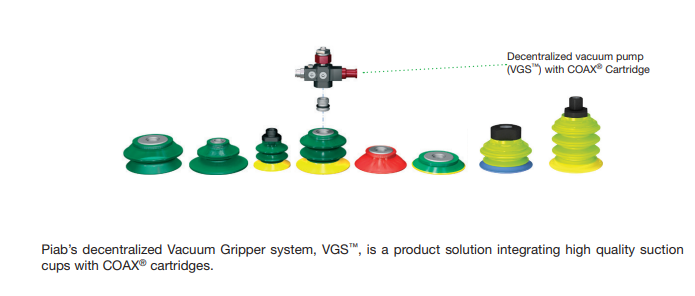
Figure 6.3 Vacuum Grippers
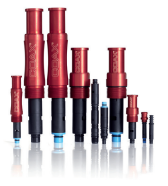
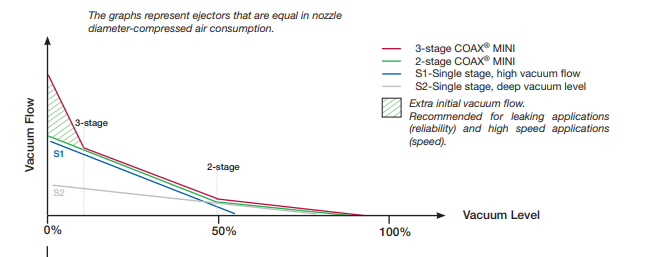
Figure 6.4 COAX® technology
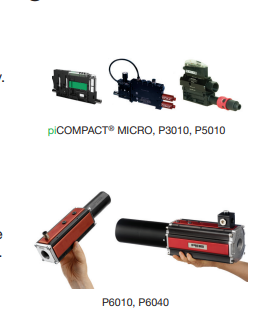
Figure 6.1 Vacuum pumps
 write
write